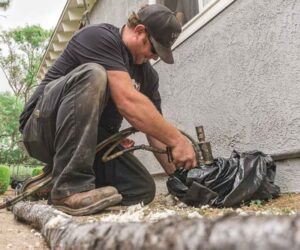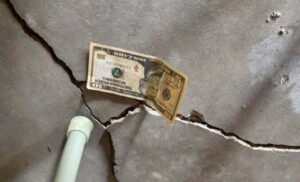Deep injection doesn’t sound like something you would think about with foundation repair. You would think you’re going to the doctor’s office for a deep injection for whatever sickness you (don’t) have. Thankfully, doctors won’t be sticking a needle in you for your foundation repair.
When thinking about foundation repair, you might think of underpinnings with concrete or steel piers. There’s more that goes into it.
What if I told you there is a foam injected into the ground that densifies the soil to be as hard as concrete?
Dalinghaus Construction has been in the foundation repair business since 2015 in Southern California, Arizona, and Nevada, having over 100 years of combined experience. We know foundation repair, from installing galvanized steel pier underpinnings to deep injections with polyurethane.
What is deep injection?

Deep injection is systematic layering at different depths underneath a structure to densify soil. Voids and microvoids will be filled to strengthen and stabilize the soil.
This is usually done after lifting a slab-on-grade foundation home via a galvanized push pier or helical pier underpinning. That way the soil is stabilized enough to stabilize all areas of your foundation.
There are various ways to do deep injection such as mud jacking, but that is a more archaic method of deep injection. This involves pumping concrete into the soil to fill voids. It’s messy like a chef that doesn’t organize their workstation.
Pro tip – don’t have your cooked meats by raw meats.
Many foundation repair companies have been using polyurethane for deep injection. It’s far less messy and invasive.
What is polyurethane?

Polyurethane foam is an injectable polyol and isocyanate resin that expands when the chemical compounds fuse. This is used for void fill, structural support, and releveling properties.
It’s not only used for construction or stabilization purposes. You’ll also see polyurethane used for furniture, automotive, electronics, flooring, and even medical purposes. It can be implanted into the human body for things such as pacemakers. Polyurethane has so many uses to the point you can name a category and see where it fits in.
Polyurethane poses no threat to you or your family, property, or pets. It’s environmentally safe. You don’t need to worry about nuclear radiation causing any of your friends or family to become a supervillain.
This foam is waterproof, flame-retardent, noninvasive, and non-polluting.
The foam expands in all directions, making it so it can do more than stabilize; it can lift your home (assuming the soil conditions allow it).
And it’s significantly lighter than the concrete used for mud jacking.
Concrete can weigh 140 points per cubic foot.
Polyurethane can weigh 3-5 pounds per cubic foot.
It also cures at a faster rate compared to concrete. Concrete can take weeks to fully cure. Polyurethane cures in 15 minutes to be as hard as concrete.
Why is the weight of polyurethane important?
The purpose of deep injection is to stabilize the soil to prevent foundation settlement, meaning an area of your home is sinking into the ground.
The last thing you want is to add and deploy a second anchor to a ship that’s already sinking. That’s another problem with mud jacking. Given how heavy concrete is, it sometimes exacerbates the foundation settlement problem. Foundation settlement can be worse if the heavy concrete doesn’t make it past the active zone.
And concrete shrinks as it cures, meaning it’s less effective for stabilization.
Polyurethane being lighter makes it easier to stabilize the soil and prevent sinking.
Read our article on the definition, history, and how polyurethane is used for foundation repair.
How is deep injection used for foundation repair?
We’ve covered much of this, but we’ll go deep injection more… in-depth. Zing.
Void fill
You’ll mostly see deep injection used to fill in voids and microvoids in the soil. That way the soil is strengthened or stabilized so your home or business doesn’t deal with foundation settlement.
For structures, deep injection will be used in conjunction with galvanized steel push piers or helical piers after a lift. This is for buildings with a slab-on-grade foundation since the concrete slab needs stable soils.
You’ll also use deep injection to fill voids on hillsides to densify the soil and prevent lateral movement.
Deep injection will be used for seawalls to fill voids and prevent hydrostatic pressure since water builds up.
Structural support
This can go hand in hand with the void fill portion. You don’t need to have pier underpinnings to provide structural support.
The times you need piers with the deep injection will be due to soil conditions. You won’t be able to apply polyurethane by itself if the soil is highly expansive. Even though poly doesn’t expand or contract, the soil does, meaning you’ll have unwarranted movement affecting your home.
Ideally, you want to use deep injection with polyurethane with grainier soils. That way they can mesh up well together like ice cream on top of a warm cookie.
Releveling
If someone told you a foam could lift a building, would you believe it?
This foam expands up, down, and all around and doesn’t shrink. As more poly is added to the soil, the pressure builds up to lift the structure.
It’s not a significant lift, but it can raise a home by an inch if conditions are good. Don’t expect to stabilize and lift your home. Again, it depends on soil conditions.
Releveling also works well with concrete such as your driveway or a sidewalk. Hell, we’ve been able to lift parts of a road and have it drivable in 15 minutes.
Cost of deep injection

Dalinghaus Construction charges $110 per square foot for deep injection with polyurethane.
Again (again), it all comes down to soil conditions and what’s practical for your foundation repair.
Consider Dalinghaus Construction to do your deep injection
You’ve learned about what deep injection is, polyurethane, how deep injection is used for foundation repair, and the cost of deep injection with polyurethane. Dalinghaus Construction can fulfill your foundation repair needs, whether it’s an underpinning, deep injection, or a little bit of both.
You can schedule a FREE foundation evaluation to see if deep injection is a solution for your foundation repair.
Learn more about the 5 steps to polyurethane foam injection.
Take a look at our article on the cost of underpinning with polyurethane.
For additional questions or to schedule an evaluation, call Dalinghaus Construction at (877)360-9277.






